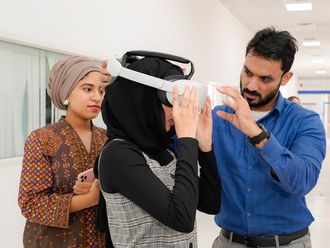
Health-care organisations in the UAE are working to create a safe and high-quality medical care system and to prevent mistakes that can endanger patient safety. However, considering the complexity of such systems and the vulnerability of patients to human error and accidents, improving patient safety is challenging and requires constant monitoring of services and performance. Collaboration among all stakeholders — from policymakers to care providers, hospital managers to frontline workers — and an environment where all are empowered to speak up without fear of retribution, are key to fostering a culture of safety in any organisation. And it’s here that Joint Commission International (JCI) plays a critical role.
JCI is the international divi-sion of Joint Commission Re-sources, a global knowledge-based organisation providing innovative solutions to help the health-care industry improve patient safety and quality. The leader in international accreditation for health-care organisations, JCI has been actively involved in the UAE’s health-care sector — it provides standards and frameworks for strengthening patient safety efforts by addressing an organisation’s performance in key functional areas such as patient rights, patient treatment, medication safety and infection control. The physical environment and planning for emergencies such as natural disasters are also addressed by JCI standards.
Dr Ashraf Ismail, M.D., M.P.H., C.P.H.Q. is Managing Director of JCI’s Middle East office. He talks to GN Focus about the importance of JCI’s accreditation process and how JCI can help hospitals achieve patient safety and high-quality care.
Why is accreditation important?
Issues related to patient safety and the provision of safe care are now of primary importance for health-care organisations worldwide. It is critical for hospitals to align their care and services with established international standards and to benchmark these against international leading practices. JCI standards, for instance, focus on performance improvement strategies that can help health-care organisations improve quality of care, which can help reduce unintended injuries, complications and medical errors. Accreditation involves not only preparing for a survey, but maintaining an ongoing high-level of quality and compliance with standards. We also provide guidance to organisations on quality improvement efforts.
How would you rate safety standards in the UAE?
We are extremely happy with our reach in the UAE, which has the highest number of JCI-accredited organisations in the world. Currently, 84 hospitals in the UAE are accredited by JCI. Whether it is a hospital, laboratory, ambulatory clinic or home health-care programme, JCI standards can help organisations improve risk management and risk reduction, and create a culture of safety. The UAE maintains high standards in health-care facilities.
We know the design of a hospital can significantly improve patient safety by preventing adverse events, such as falls. Most clinics and hospitals in the UAE are relatively new — they have been developed in the past 20 or 30 years — and this gives them an edge over other organisations in the region. From architectural design to equipment and technologies, new hospitals in the UAE follow the latest standards in facility design. The rates of medical errors or unintended injuries have reduced significantly in the UAE in the past few years. We are working with health-care organisations to continuously improve processes and educate staff and patients about the importance of implementing patient-safety standards. Our goal is to help organisations offer a zero-def-ect health-care experience.
Is the prevention of infections important?
There is no doubt the prevention and control of infections in hospitals and health-care organisations of all types is of absolute importance. Our standards place a high priority on this. Poor infection control practices put vulnerable patients at risk.
A key priority for accredited hospitals and clinics is the prevention of health care-associated infections (HAI). An HAI is a secondary infection, such as clostridium difficile or pneumonia, that a patient contracts while being treated for another condition in a health-care setting. Most HAIs are preventable if hospitals adhere to infection prevention and control measures. We offer hospitals the required technical assistance and education they need to build and sustain comprehensive and effective infection prevention programmes in their facilities.
What are the biggest challenges to patient safety?
Despite serious initiatives aimed at improving patient safety and quality of care, lapses in safety standards still represent a significant challenge. In an effort to highlight the most problematic and challenging areas, the JCI International Patient Safety Goals are included in the standards manual and spotlight some of the most pressing patient safety issues we want hospitals to focus on.
The goals include evidence- and expert-based solutions. There are six goals for ensuring correct patient identification: effective communication; safe use of high-alert medication; correct-site, correct-procedure and correct-patient surgery; and reducing the risk of HAIs and patient harm resulting from falls. Recognising that sound system design is intrinsic to the delivery of safe and high-quality health care, these goals generally focus on system-wide solutions wherever possible. Another area that JCI has identified for improvement is related to technology, which is increasingly making the health-care environment even more complex. Whether it is medical equipment, information technology or medication administration technology, with the implementation of every new technology, new risks to patients are introduced. JCI’s programme for safe adoption of technology helps organisations ensure that the technology used in hospitals is safe for patients, families and providers.
What is the role of a leader in promoting safety?
The success of a patient safety initiative depends on its leaders and senior management.
It is not only their commitment to patient safety but also their education and participation in implementing patient safety that matters. Hospitals should have meaningful processes to prevent adverse events. Effective implementation of patient safety initiatives requires timely identification of unsafe practices and conditions, and proper analysis of reported adverse events. A culture of blame and punishment often fails to provide desired results. Furthermore, it discourages staff from reporting errors and accidents. It is the responsibility of leaders to make sure all employees feel empowered to report any issue that they feel has an impact on patient safety and the quality of care, without the fear of being disciplined. Part of the problem, of course, is that senior leaders are often not aware of the safety issues in their organisations.
They need to be in the hospitals and must play an active role in identifying problems and correcting them to improve the quality of care.
Are patient rights and education critical for their safety?
Patient and family involvement is an essential part of quality health care. Poor communication and lack of awareness about safety issues are major causes for medical errors and adverse events in hospitals.
A patient has the right to make decisions about their care and treatment, and should be informed about their condition, diagnosis, alternative treatment options and the risks of a procedure. Hospitals should communicate with patients in a language they understand so that they don’t face medical errors due to miscommunication.
Patients should be empowered to say something when they spot a safety lapse in the hospital. JCI has the well-known Speak Up Initiative to educate patients to ensure they get the best and safest care and how to approach a health-care provider if they think something isn’t quite right. Cooperation between patients and health-care providers should be a critical component of the patient safety strategy in any hospital.












